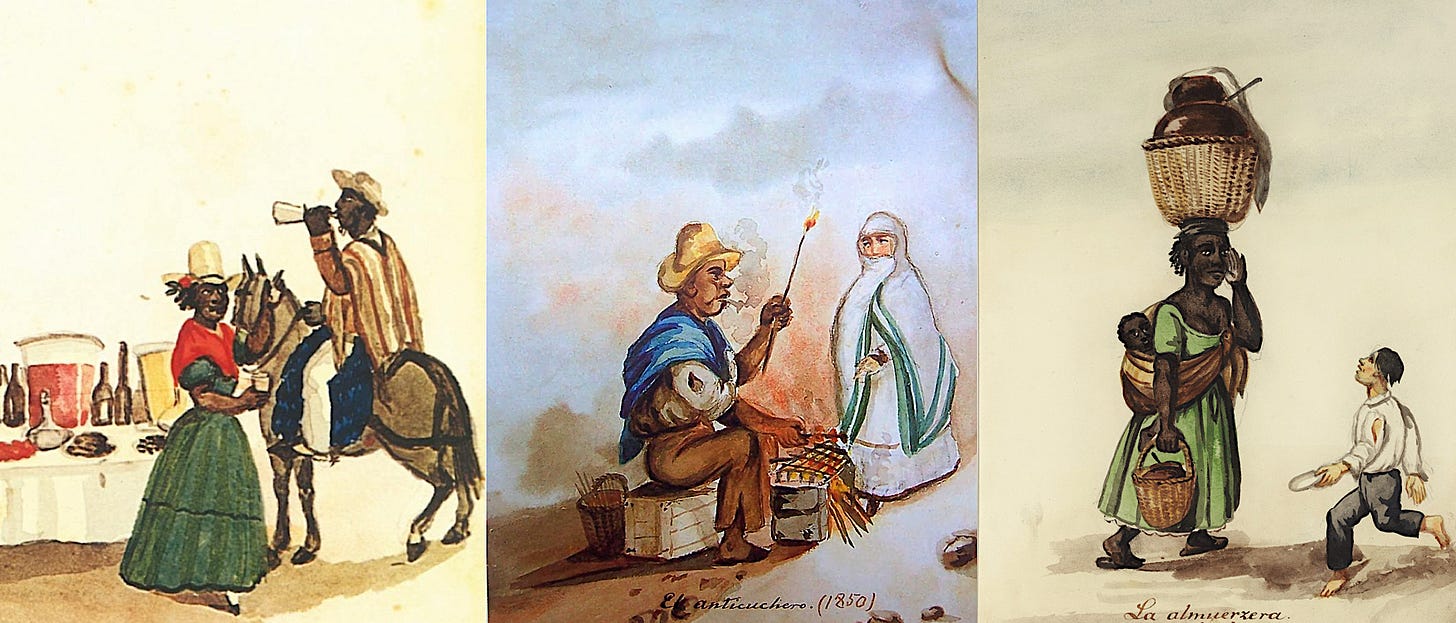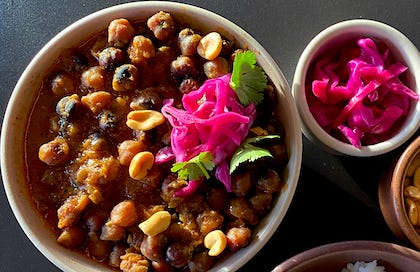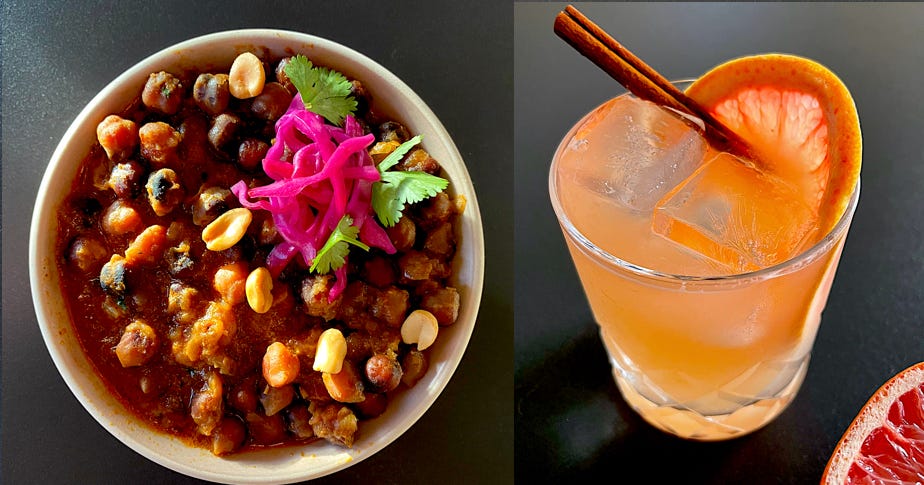This month’s newsletter celebrates the culture of Black Peru. I invite you to cook an Afro-Peruvian stew, drink a pisco cocktail, listen to Afro-Peruvian music, and learn how a Black poet reclaimed his roots.
Lima’s Afro-Peruvian Street Food Vendors

Today, Lima is famous for its street food like anticuchos (beef heart kebabs marinated in vinegar and aji panca) or picarones (sweet potato doughnuts bathed in spiced syrup). But it was more than 100 years ago that Afro-descendants cooked Lima’s creole food in the markets and streets of Lima.
Ricardo Palma, Peru’s mestizo chronicler, wrote about their daily routine. From 6 a.m. to 7 p.m., street food vendors sang pregónes to announce their offerings of tamales, empanadas, picarones, anticuchos, and more.
The complement to Palma’s stories was Pancho Fierro’s watercolors. Through his illustrations, the creole artist documented the lives of Lima’s Afro-descendant street food vendors. Fierro’s 1,200 watercolors were like the Instagram of the 1800s.
The tryptic above shows three different vendors. On the left, a Black woman sells chicha corn beer and small bites. In the center, a Black man grills anticuchos. On the right, an Afro-descendant woman carries lunch on her head and an infant on her back.
To learn more about Afro-Peruvian food culture, read my stories:
The Soul Food of Black Peru (TASTE, 2020)
The Origin of Lima’s Creole Street Food (W Journal, 2020)
and listen to Dr. Jessica B. Harris’ Peru episode on My Welcome Table.
Afro-Peruvian Stew and Pisco Cocktail
In Afro-descendant communities south of Lima, like El Carmen or Chincha, families cook carapulcra, a spicy dehydrated potato stew from the Andes.
In one variation of carapulcra, toasted chickpeas replace the potatoes. Hot peppers provide heat, and the aroma of cloves, anise, and cinnamon permeates the savory stock thickened with peanut butter.
To celebrate the culinary heritage of Black Peru, I invite you to cook my vegan Afro-Peruvian Carapulcra Chickpea Stew and pair it with el chirulín—a centuries old Afro-Peruvian pisco cocktail that Afro-descendant families in El Ingenio prepare with pomelo. Here is my version:
El Chirulín
1 ounce cinnamon spiced syrup
1 ounce pisco, Quebranta or Acholado varietal
2 ounces fresh grapefruit juice
a grapefruit round and cinnamon stick, for garnishFor the cinnamon spiced syrup, in a small sauce pan over medium heat, bring 1 cup of water to a boil. Then, mix in 1 cup of sugar and stir to dissolve, about 1 minute. Remove from the heat, add two cinnamon sticks, and let rest for 30 minutes. Compost the cinnamon sticks, pour the syrup into a mason jar, and let it cool before using.
Combine the cinnamon spiced syrup, pisco, and grapefruit juice in a shaker with ice, then shake to chill. Strain into a glass with ice, garnish with a grapefruit round and cinnamon stick.
¡Salud! / Cheers!
Afro-Peruvian Music
In Peruvian family celebrations, where there’s food there’s always music and dance. Just like Black cooks crafted some of Peru’s first creole dishes, Afro-Peruvian rhythms are an integral part of Peru’s cultural identity.
Over the past four decades, Afro-Peruvian music—once all acoustic percussion, vocals, and guitar—has evolved to incorporate modern instruments such as electric bass, synthesizer, and drum kit.
Contemporary band Novalima remixes the Afro-Peruvian classic Camote,
while Afro-Peruvian singer Susana Baca adds jazz-style arrangements to Negra Presuntuosa.
These songs are deeply rooted in the ancestral Black rhythms that Nicómedes Santa Cruz honors in Samba Malató.
In the documentary film Sigo Siendo, musicians at a bar in Lima perform the Afro-Peruvian song Cardo ó Ceniza, a landó rhythm with vocals, bass, guitar, quijada (jaw bone), and the Afro-Peruvian cajón—a wood box drum that enslaved people crafted during the Viceroyalty of Peru.
In another scene, at the Afro-Peruvian community of El Carmen, families celebrate with music and dancing in the streets. One of the families is the Ballumbrosio—Afro-descendant percussionists, dancers, and cooks whose patriarch was famed zapateador dancer, Amador Ballumbrosio.
Afro-Peruvian Décima Poems
Siblings Nicómedes Santa Cruz and Victoria Santa Cruz were activists, poets, musicians, and choreographers that reclaimed and revived the songs, music, dance, rhythms, and history of their ancestors—enslaved people from Africa.
In 1957, Nicómedes Santa Cruz wrote Ritmos Negros del Perú, a décima poem about the roots of Afro-Peruvians. The poem begins, in Spanish / English, with these raw, powerful lines:
Ritmos de la esclavitud / Rhythms of slavery
contra amarguras y penas. / Against bitterness and sorrow.
Al compás de las cadenas / Keeping time to the beat of the chains
ritmos negros del Perú. / Black rhythms of Peru.De África llegó mi abuela / My grandmother arrived from Africa
vestida con caracoles, / dressed with sea shells,
la trajeron lo` epañoles / the Spaniards brought her
en un barco carabela. / in a caravel ship.
La marcaron con candela, / They marked her with candle fire,
la carimba fue su cruz. / the branding iron mark was the cross she bore.
Y en América del Sur / And in South America
al golpe de sus dolores / to the strike of her pains
dieron los negros tambores / the Black drums created
ritmos de la esclavitud / rhythms of slavery
The cadence and structure of the décima style is evident in a song version of the poem, performed by Santa Cruz.
Black Soulfulness
The first time I heard the phrase “el son de la negritud” it referred to the soulful music of Black cultures. Peru’s creole food is profoundly infused with this soulfulness. And cooking it becomes an act of resistance that celebrates and preserves the culinary traditions of Black Peru.





Nico! I LOVED this newsletter. So informative and beautiful. In my own research I've learned so much about Black Peruvians and it's such a rich complex history that I'm glad you're also sharing it with the world 💗✨.